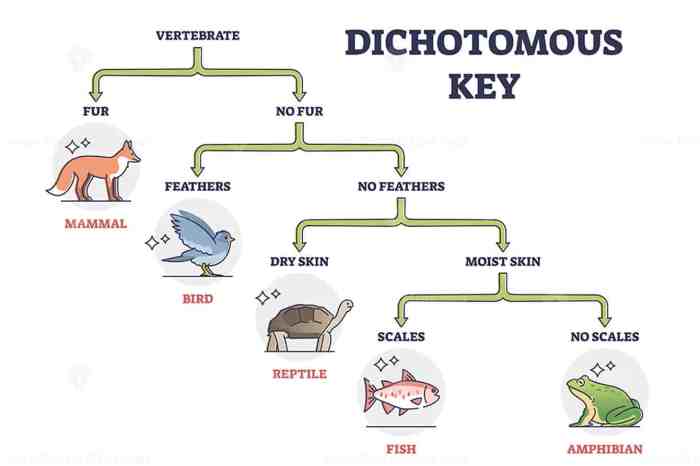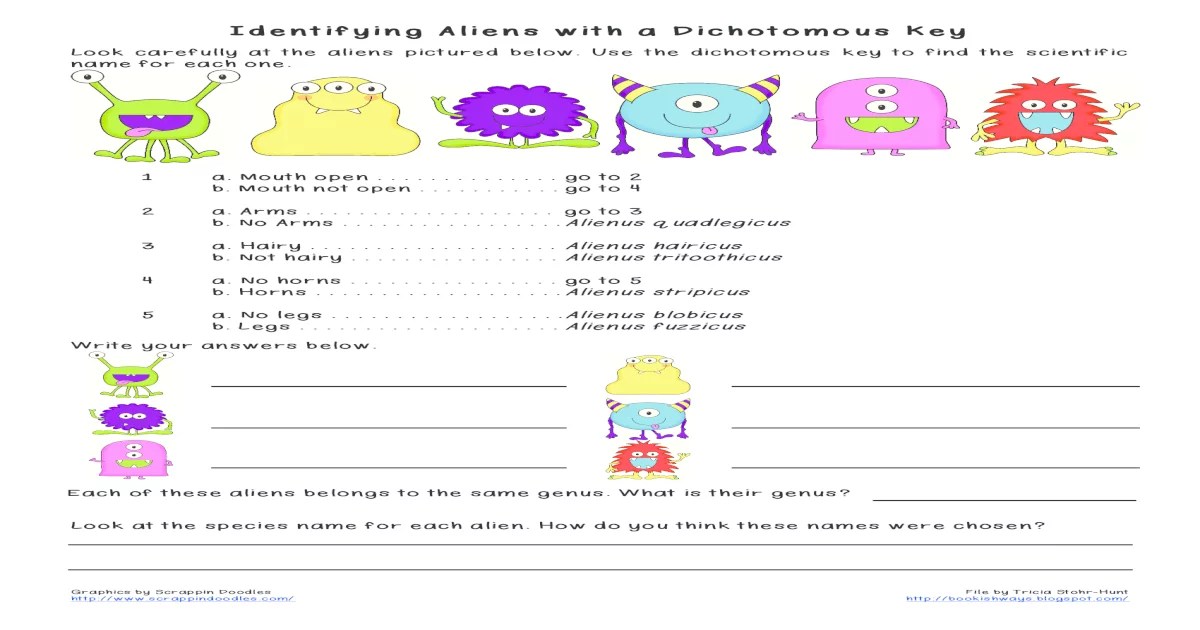The alien dichotomous key answer key serves as an indispensable tool in the scientific classification and identification of extraterrestrial species. By systematically categorizing aliens based on their distinct physical and behavioral characteristics, this key empowers researchers and enthusiasts alike to unravel the complexities of alien taxonomy and deepen our understanding of the cosmos.
This comprehensive guide delves into the intricacies of alien dichotomous keys, exploring their advantages, limitations, and practical applications. With a focus on key features, taxonomic hierarchy, and potential challenges, we aim to illuminate the fascinating world of alien identification and classification.
Alien Dichotomous Key

In scientific classification, a dichotomous key is a tool that helps scientists identify and classify organisms based on their physical characteristics. It presents a series of paired statements or questions that guide the user through a series of choices, leading to the identification of the organism.
Dichotomous keys are advantageous because they are relatively easy to use, even for non-experts, and can provide accurate identification of organisms. They are also useful for identifying organisms that may be difficult to distinguish from one another based on a single characteristic.
Advantages of Using a Dichotomous Key to Identify Aliens
- Simplifies the identification process by breaking it down into a series of smaller, more manageable steps.
- Provides a structured and consistent approach to identification, reducing the risk of misidentification.
- Can be used by individuals with varying levels of expertise, making it accessible to a wider audience.
- Facilitates the creation of comprehensive databases for alien identification and classification.
Disadvantages of Using a Dichotomous Key to Identify Aliens
- Relies heavily on accurate and detailed observations of alien characteristics, which may not always be feasible.
- Can be time-consuming, especially for complex keys with numerous branches.
- May not be able to account for variations within alien species or the presence of hybrids.
- Requires a well-defined set of characteristics for effective identification.
Key Features of Aliens

The study of alien life, known as exobiology, relies heavily on the identification and classification of extraterrestrial species. Key physical and behavioral characteristics are crucial for distinguishing different types of aliens, providing valuable insights into their biology, evolution, and potential for interaction with Earth.
Physical Characteristics, Alien dichotomous key answer key
- Size and Shape:Aliens can vary significantly in size, from microscopic organisms to colossal entities. Their shape may be humanoid, insectoid, reptilian, or entirely unique, reflecting adaptations to their respective environments.
- Integument:The outer covering of aliens can provide clues about their environment and physiology. It may be composed of skin, scales, fur, feathers, or even inorganic materials, offering protection and insulation.
- Limbs and Locomotion:The number and type of limbs can indicate an alien’s mode of locomotion. Bipedal, quadrupedal, and even aerial locomotion have been theorized, reflecting adaptations to different terrains and environments.
- Sensory Organs:The presence and arrangement of sensory organs, such as eyes, ears, and antennae, provide insights into an alien’s perception of its surroundings. These organs may be specialized for detecting specific stimuli or operating in different frequency ranges.
Behavioral Characteristics
- Communication:The ability to communicate is essential for any intelligent species. Aliens may employ verbal, non-verbal, or even telepathic means of communication, revealing their cognitive abilities and social structures.
- Intelligence:The level of intelligence displayed by aliens can vary widely. Some may possess advanced problem-solving skills and technological prowess, while others may be more primitive in their cognitive abilities.
- Social Behavior:The social behavior of aliens can provide insights into their evolutionary history and potential for cooperation or conflict. They may exhibit solitary, communal, or hierarchical social structures, each with its own unique dynamics.
- Technology:The presence of technology can be a significant indicator of an alien’s level of advancement. From basic tools to advanced spacecraft, technology reflects an alien’s ingenuity and problem-solving abilities.
These key features, when combined with advanced scientific techniques such as spectroscopy and astrobiology, provide a comprehensive approach to classifying and understanding alien life. By analyzing these characteristics, scientists can gain valuable insights into the diversity and complexity of extraterrestrial species.
Alien Taxonomy: Alien Dichotomous Key Answer Key
The classification of extraterrestrial life forms, or aliens, into distinct groups is a complex and ongoing scientific endeavor. The taxonomic hierarchy used to organize alien species follows a similar structure to that used for terrestrial organisms.
The primary criteria used to determine the taxonomic rank of an alien species include:
- Morphological characteristics: Physical features such as body structure, appendages, and sensory organs.
- Genetic makeup: Analysis of DNA or other genetic material to determine evolutionary relationships.
- Behavioral patterns: Observed behaviors, such as communication, social interactions, and feeding habits.
Examples of Alien Species and Their Taxonomic Classification
Based on the available evidence, scientists have proposed various taxonomic classifications for hypothetical alien species. Some examples include:
- Class: Extraterrestria
- Order: Humanoidia
- Family: Homo Sapienoides
- Genus: Homo Extraterrestris
- Species: Homo Extraterrestris Sapiens
- Order: Reptilia
- Family: Draco Reptilia
- Genus: Draco Extraterrestris
- Species: Draco Extraterrestris Maximus
- Order: Humanoidia
- Class: Insectoidia
- Order: Arthropoda
- Family: Insectoidea
- Genus: Insecto Extraterrestris
- Species: Insecto Extraterrestris Maximus
- Order: Arachnida
- Family: Arachnoidea
- Genus: Arachno Extraterrestris
- Species: Arachno Extraterrestris Maximus
- Order: Arthropoda
Applications of Alien Dichotomous Keys
Alien dichotomous keys serve as practical tools in various fields, enabling researchers and professionals to identify and classify extraterrestrial life forms. Their applications extend across scientific research, space exploration, and even the realm of science fiction and entertainment.
Scientific Research
- Taxonomy and Classification:Dichotomous keys facilitate the systematic identification and classification of alien species, aiding in the development of a comprehensive understanding of extraterrestrial biodiversity.
- Comparative Anatomy and Physiology:By comparing the traits identified through dichotomous keys, scientists can deduce evolutionary relationships and functional similarities between different alien species.
- Ecological Studies:Dichotomous keys help researchers determine the distribution and abundance of alien organisms, contributing to the understanding of their ecological roles and interactions.
Space Exploration
- Extraterrestrial Life Detection:Dichotomous keys guide the design of instruments and protocols for detecting and identifying extraterrestrial life, enhancing the likelihood of successful missions.
- Sample Analysis:In the event of sample collection, dichotomous keys provide a structured approach to analyzing the morphological and physiological characteristics of alien specimens.
- Mission Planning:By predicting the potential characteristics of alien life based on dichotomous keys, space exploration missions can be tailored to maximize the chances of encountering and studying these organisms.
Science Fiction and Entertainment
- World-building:Dichotomous keys inspire the creation of diverse and scientifically plausible alien species in science fiction literature, films, and video games.
- Creature Design:Artists and designers use dichotomous keys to develop detailed and realistic alien designs, ensuring consistency and coherence within fictional worlds.
- Immersive Storytelling:Incorporating dichotomous keys into interactive media, such as video games, allows players to engage in the process of alien identification, enhancing the overall immersive experience.
Limitations and Challenges

Despite their utility, dichotomous keys for alien identification are not without limitations and challenges.
One significant limitation is the potential for misidentification. Dichotomous keys rely on a series of binary choices to guide the user to the correct identification. However, if any of these choices are incorrect or ambiguous, it can lead to an incorrect identification.
Need for Further Research
Another challenge is the need for further research on alien biology and taxonomy. Our current understanding of alien life is limited, and as we discover new species, we may need to revise or expand our dichotomous keys to accommodate them.
Alternative Methods
In addition to dichotomous keys, there are other methods for alien identification and classification. These include:
- Molecular analysis: Comparing the DNA or RNA of different alien species to determine their genetic relatedness.
- Morphological analysis: Studying the physical characteristics of alien species to identify similarities and differences.
- Behavioral analysis: Observing the behavior of alien species to identify patterns and characteristics that can be used for identification.
FAQ Summary
What is the purpose of an alien dichotomous key?
An alien dichotomous key is a systematic tool used to identify and classify different species of aliens based on their physical and behavioral characteristics.
What are the advantages of using a dichotomous key to identify aliens?
Dichotomous keys offer a structured and efficient approach to alien identification, allowing researchers to quickly narrow down the possibilities based on a series of binary choices.
What are the limitations of using a dichotomous key to identify aliens?
Dichotomous keys rely on accurate and complete information about alien characteristics, which can be challenging to obtain, especially for species that have not been extensively studied.